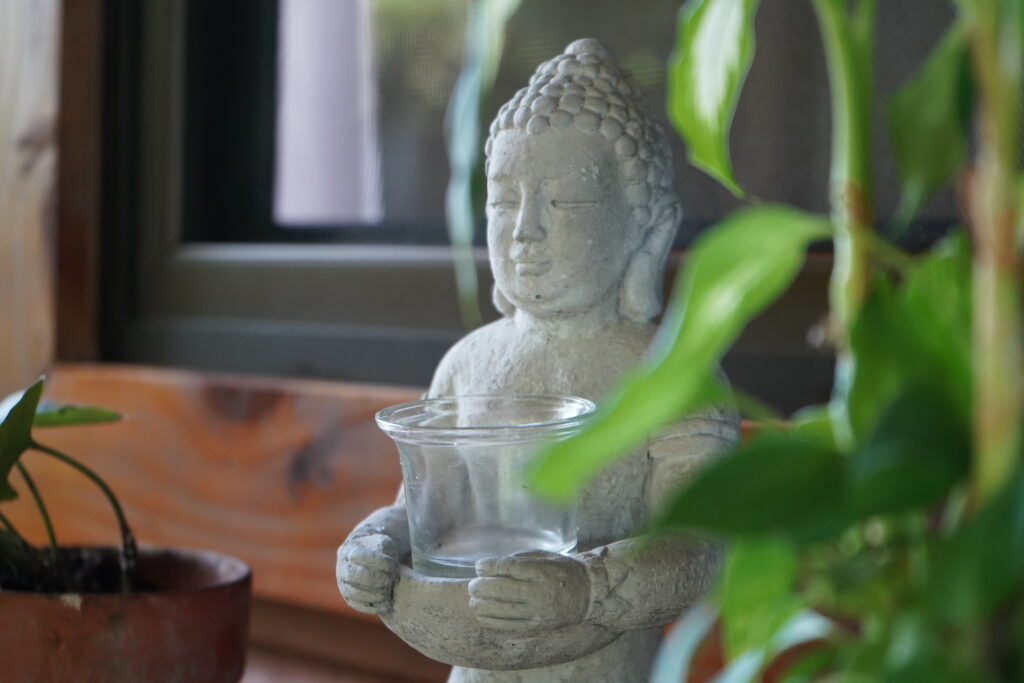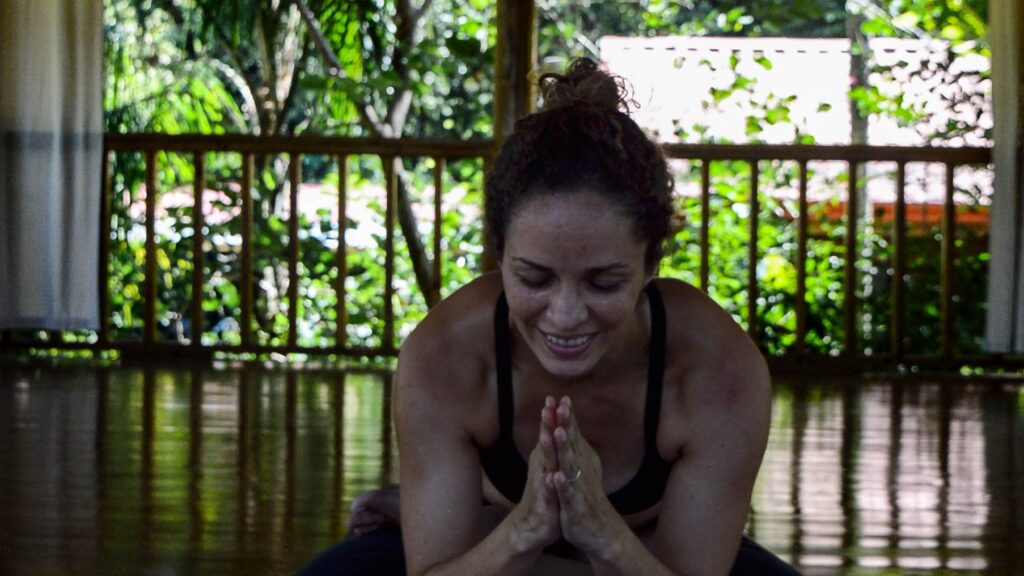Have you ever wondered about the meaning behind the famous “prayer hands” gesture in yoga? Well, that’s the Anjali Mudra, a sacred hand position that carries deep significance.
In this post, I’ll dive into the profound symbolism of Anjali Mudra and guide you on how to incorporate it into your practice. Get ready to elevate your yoga experience and connect with the essence of this ancient tradition!
What Does Anjali Mudra Mean?
Anjali Mudra is the practice of meeting the hands together by the sternum in a “prayer position.” It’s used frequently during the practice of yoga, commonly at the opening and closing of yoga classes and during other yoga asanas.
Anjali is a Sanskrit term that means “to offer” or “to salute,” and the term Mudra means “seal.” So, basically, it is the salutation seal and symbolizes that we are “honoring and celebrating this moment.”
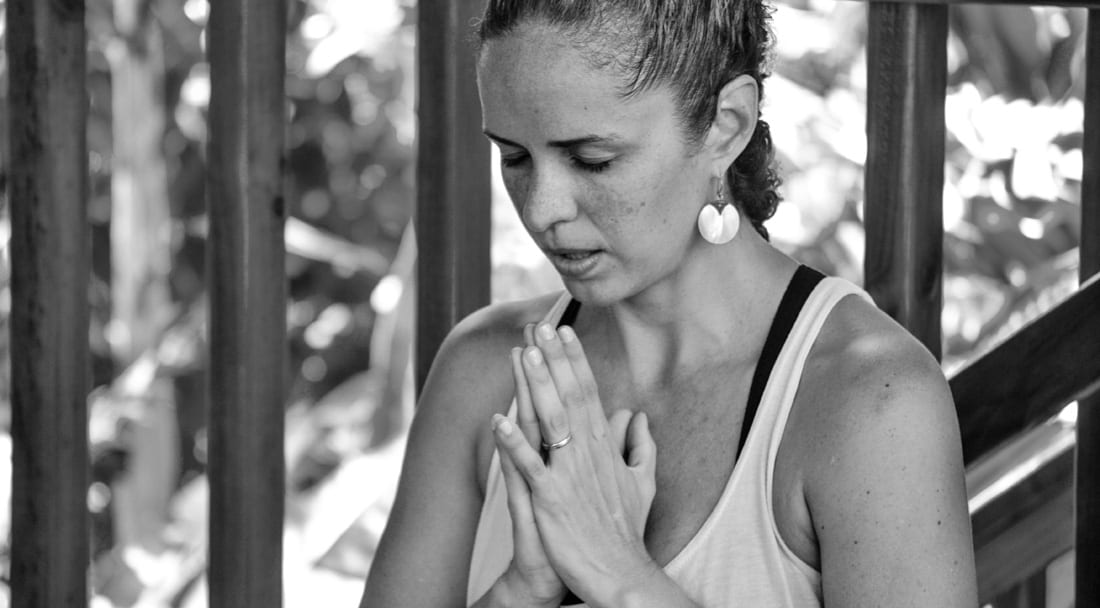
Prayer hands in yoga
An Explanation From a Yoga Master
When we do our yoga practice, it is essential to understand why we are doing what we are doing so we can do it mindfully and with intention.
You may find that the Anjali Mudra salutation seal has many meanings. The answer given by Krishnamacharya is my favorite:
“This gesture signifies the potential for an intention to progress to the greatest spiritual awakening. When done properly, the palms are not flat against each other; the knuckles at the base of the fingers are bent a little, creating space between the palms and fingers of the two hands resembling a flower yet to open, symbolizing the opening of our hearts.”
Once we truly understand the meaning of Anjali Mudra, we can embrace the reasons for it. This can help us ensure the position is based on humility rather than an ego expression or to achieve perfection on a physical level.
Anjali Mudra vs. Namaste
While Anjali Mudra and Namaste are often used interchangeably, there’s a subtle difference between the two. Anjali Mudra specifically refers to the hand position itself – palms pressed together at the heart center.
On the other hand, Namaste is the Sanskrit phrase uttered while performing Anjali Mudra. It translates to “I bow to the divine in you.” When we say Namaste with joined palms, we acknowledge the sacred spark within ourselves and others.
So while Anjali Mudra is the physical gesture, Namaste encapsulates the spiritual sentiment behind it, recognizing our shared divinity.
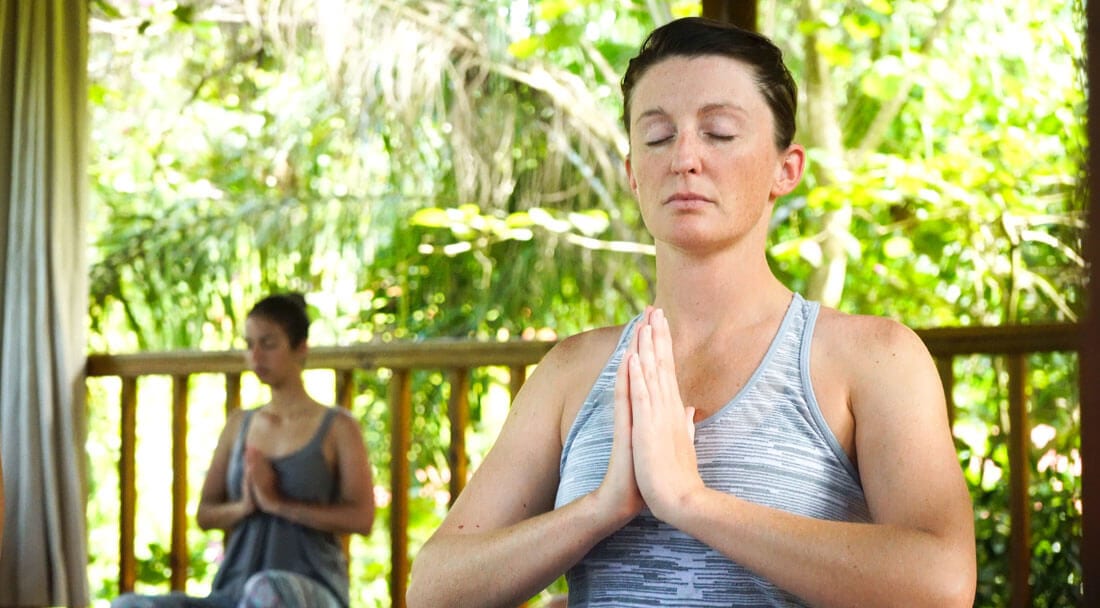
Anjali Mudra in Yoga
When Do You Use Anjali Mudra?
Anjali Mudra is often used to begin and end yoga classes to help ground, create, and seal in the deeper, personal intention of the day’s practice.
We can apply it to many asanas instead of keeping our hands separate. It can also serve as a reminder for us to keep an inner attitude of peace during our practice.
Here are a few of the asanas or physical postures where Anjali Mudra is commonly used:
- During mountain pose (Tadasana)
- Before Sun Salutations (Surya Namaskar A and B)
- In balance postures like tree pose (Vrksasana)
In any place where a moment of grounding or centering is required, this prayer mudra can be used with intention for great benefit to the practitioner.
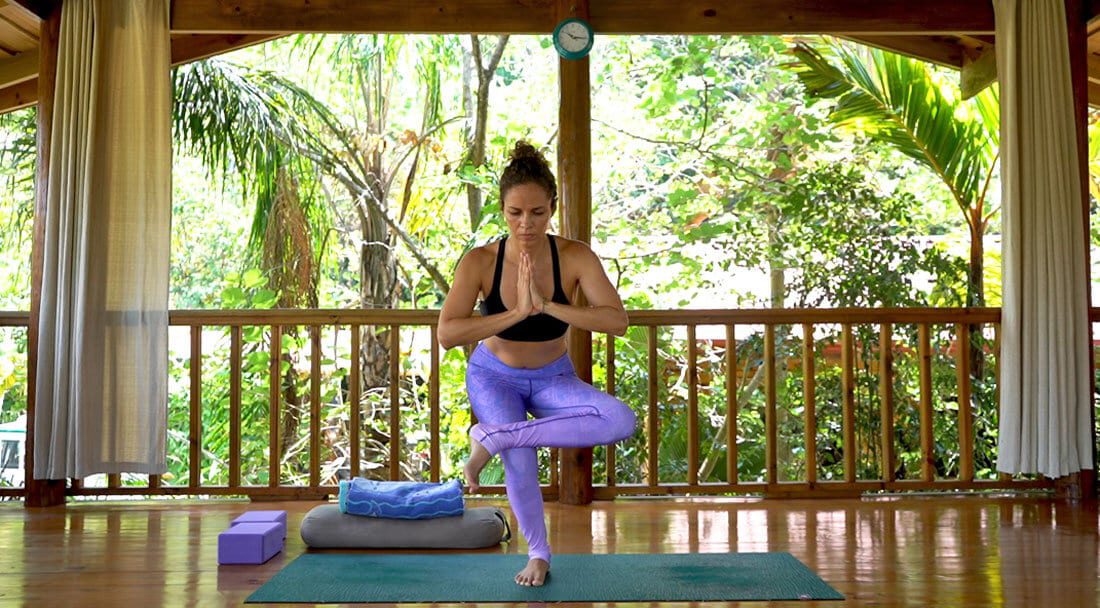
Demonstrating Anjali Mudra, aka Salutation Seal, in yoga
What Are the Benefits of Anjali Mudra?
One definition of yoga is “yoke,” which means union, and the union of the hands can symbolize many things.
For example, the unity of both sides of the brain and body. It is done with the hands in front of the heart, which promotes heart-openness.
As you practice yoga, you will see these pinnacle concepts repeat.
Anjali Mudra is Pranam Mudra, Namaste Mudra, or the prayer Mudra. Most of the time, we perform it with our hands in the center of our heart chakra. This represents the balance and harmony between the right and left sides reunited in our center.
This balance can be not only physical but also mental and emotional. The idea is to bring us to the center to prepare ourselves for meditation and contemplation.
A Grounding Practice
As Anjali Mudra is a gesture of prayer, it can be used to that end. It is often accompanied by namaste, which means “I bow” to the divinity within you from the divinity within me.”
It’s a moment and action to honor the divine: oneself, one’s intention, others, or something even more significant; a higher purpose. It’s a moment to come back to yourself and your intention. It promotes balance, uniting the left and right hemispheres of your brain. It’s grounding and calming!
As explained by Yoga International, this can be beneficial for so many realms of your life:
When the mind is calm, harmonious, and concentrated, you gain a deep understanding of yourself and others. Your comprehension expands, enabling you to see the world and your place in it in a light charged with appreciation for what you truly are.
Your list of complaints begins to dwindle. You are no longer uncomfortable with others or with the circumstances of your life, and so you start to bask in a positive and joyful atmosphere, both in your internal world and outside.
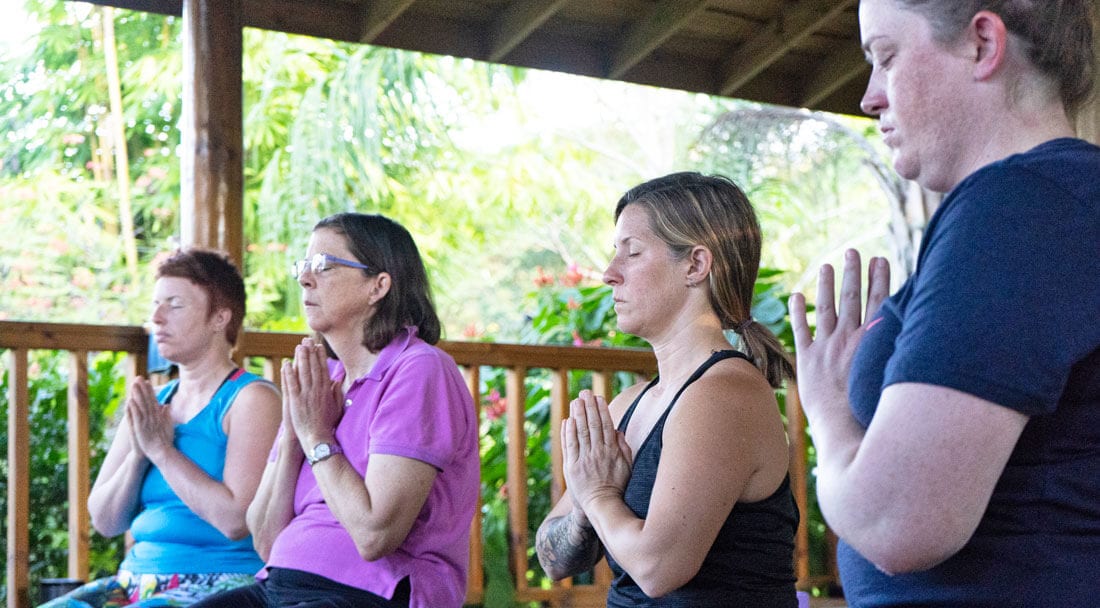
Using Anjali Mudra in yoga class
How Can You Do Anjali Mudra Yourself?
In yoga, Anjali Mudra provides a moment of centering, which is why it is commonly done at the beginning or end of your physical practice.
You can do Anjali Mudra yourself by adding it to your existing routine. Just take a moment of intentionality at the beginning or end. Utilize the moment to honor or connect with something great.
Another way to do Anjali Mudra is during the beginning or even throughout a meditation. Meditation is an excellent and immensely beneficial wellness practice that significantly reduces stress, promotes calmness, heightens focus, and transcends unhelpful mental patterns.
So, to get started, sit in a comfortable pose (Sukhasana). Place your hands together in front of your heart in Anjali Mudra. Close your eyes. Breathe in and out deeply through your nose, practicing Pranayama.
Focus your mind and your attention to an intention. It could be for any of the following reasons:
- Slow down the fluctuations of your mind
- Guidelight and love towards someone in your life
- Simply a moment to reconnect with yourself (your wants, needs, and feelings)
Anjali Mudra will help seal this honoring, celebrating, and salutation moment.
FAQs
How long does it take to do Anjali Mudra?
There’s no set duration for performing Anjali Mudra. It’s a flexible practice that can be adapted to your needs and schedule.
You can hold the mudra for an extended period, like 35 minutes, if you wish to use it as a meditation technique. Alternatively, you can practice it in shorter bursts of 10-15 seconds, repeating 3-4 times throughout the day!
The beauty of Anjali Mudra lies in its versatility – it can be seamlessly woven into your daily routine, whether you have a few moments or a dedicated practice session.
What does Anjali Mudra represent?
Anjali Mudra represents a few key things, the most notable of which are:
- Unity and Integration: It symbolizes joining the two sides of the body together at the center of the heart. This represents bringing harmony and balance between the different aspects of our being – physical, mental, and emotional.
- Initiation and Completion: Anjali Mudra is often used to begin or end a practice, ritual, or action. It signifies initiating something with intention and presence, as well as sealing or completing it in a reverent way.
Our online yoga classes will show you how to incorporate the yoga philosophy and its numerous benefits — physical, mental, and spiritual — into your life!

Your Journey Starts Here
Ready to Finally Experience That Life-Changing Surf + Yoga Trip (Without the Overwhelm)?
Bust the 5 biggest myths about going to a surf and yoga camp so you can stop procrastinating and start catching waves - with our FREE 5-day email course.
Change the heading on the Separator tab ->
Search
Get a Toolkit to Create Calm in Your Inbox
Watch the first lesson from our full immersive course: 8 Limbs of Ashtanga Yoga, FREE!
Change the heading on the Separator tab ->
Most Read Blogs
What is the Meaning of Anjali Mudra?
May 27, 2020
Fitness for Surfers: Workouts, Exercises & Training
February 10, 2022
The Best Places to Eat in Uvita, Costa Rica
May 19, 2022
How to Get From SJO to Costa Ballena, Costa Rica
May 31, 2018
Change the heading on the Separator tab ->
Categories
Categories
- Bodysurfing (5)
- Food (8)
- Responsible Business (6)
- Surfing (66)
- Travel (65)
- Yoga (44)
Change the heading on the Separator tab ->
Newsletter
Thanks for subscribing! Please check your email for further instructions.
Change the heading on the Separator tab ->
Follow Us
Pilar
Change the heading on the Separator tab ->
Read more
Ayurveda Series – Cooking with Prana
Words by Pilar
Welcome back! We’re thrilled that you’ve decided to join us as we dive into our third blog in Pilar’s discovering Ayurveda series – Cooking with Prana. Just to jog your memory, Pilar…
Agni – Ayurveda’s Most Vital and Dynamic Principle
Words by Pilar
What if we told you that you could change your life by reading just one blog post? While that might be a bit far fetched, we’re convinced that we could all benefit…
Intro to Ayurveda: Pilar’s Exploration into the Ancient Science of Longevity
Words by Pilar
If you’ve visited us recently and spent time with Pilar specifically — whether on the yoga mat or over breakfast, you’ve likely heard her mention the word “Ayurveda” multiple times. That’s no…


